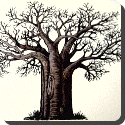 Baobab — Baobab is the common name of a genus (Adansonia) containing eight species of trees, native to Madagascar (the centre of diversity, with six species), mainland Africa and Australia (one species in each). The mainland African species also occurs on Madagascar, but it is not a native of that country. Other common names include boab, boaboa, bottle tree and monkey bread tree. The species reach heights of between 5–25 m, 10-80ft (exceptionally 30 m, 100ft) tall, and up to 7 m, 23ft (exceptionally 11 m, 36ft) in trunk diameter. They are noted for storing water inside the swollen trunk, with the capacity to store up to 120,000 litres, 32,000 US gallons, of water to endure the harsh drought conditions particular to each region. All occur in seasonally arid areas, and are deciduous, shedding their leaves during the dry season. Some are reputed to be many thousands of years old, though as the wood does not produce annual growth rings, this is impossible to verify; few botanists give any credence to these claims of extreme age, with current evidence suggesting they rarely exceed 400 years old.
Baobab — Baobab is the common name of a genus (Adansonia) containing eight species of trees, native to Madagascar (the centre of diversity, with six species), mainland Africa and Australia (one species in each). The mainland African species also occurs on Madagascar, but it is not a native of that country. Other common names include boab, boaboa, bottle tree and monkey bread tree. The species reach heights of between 5–25 m, 10-80ft (exceptionally 30 m, 100ft) tall, and up to 7 m, 23ft (exceptionally 11 m, 36ft) in trunk diameter. They are noted for storing water inside the swollen trunk, with the capacity to store up to 120,000 litres, 32,000 US gallons, of water to endure the harsh drought conditions particular to each region. All occur in seasonally arid areas, and are deciduous, shedding their leaves during the dry season. Some are reputed to be many thousands of years old, though as the wood does not produce annual growth rings, this is impossible to verify; few botanists give any credence to these claims of extreme age, with current evidence suggesting they rarely exceed 400 years old.
The Malagasy species are important components of the Madagascar dry deciduous forests. Within that biome, A. madagascariensis and A. rubrostipa occur specifically in the Anjajavy Forest, sometimes growing out of the tsingy limestone itself.
The leaves are also common as a leaf vegetable throughout the area of mainland African distribution, including Malawi, Zimbabwe, and the Sahel. They are eaten both fresh and in the form of a dry powder. In Nigeria, the leaves are locally known as kuka, and are used to make kuka soup. The dry pulp of the fruit, after separation from the seeds and fibers, is eaten directly or mixed into porridge or milk. The seeds are mostly used as a thickener for soups, but may also be fermented into a seasoning, roasted for direct consumption, or pounded to extract vegetable oil. The tree also provides a source of fibre, dye, and fuel.
 Kids Portal For Parents India Kids Network
Kids Portal For Parents India Kids Network






